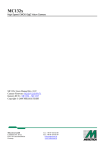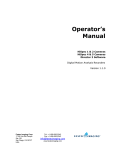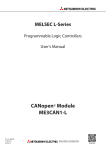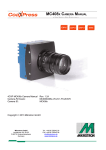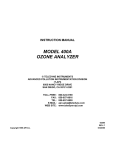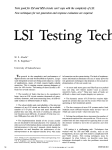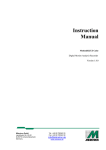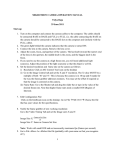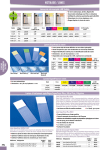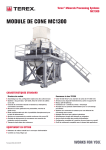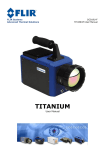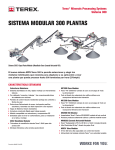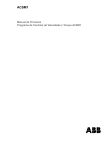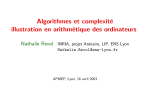Download MC1300 User Manual
Transcript
MC130x High Speed CMOS Camera MC130x Users Manual Rev. 2.1 Camera-FirmwareV2.10-F1.30 Camera ID Nr.: MC1300, MC1301 Copyright 2003 Miktrotron GmbH Mikrotron GmbH Freisinger Str. 3 D-85386 Eching Germany Tel.: +49 8165 9523 0 Fax: +49 8165 9523 95 [email protected] www.mikrotron.de General MC130x Users Manual Rev. 2.1 Table of content 1 General....................................................................... 5 1.1 1.2 1.3 1.4 1.5 1.6 1.7 2 Introduction................................................................ 9 2.1 2.2 3 First steps .........................................................................................17 Initial setup .............................................................. 18 5.1 5.2 5.3 5.4 6 Serial interface .................................................................................12 MC1300.......................................................................................12 MC1301.......................................................................................12 Digital video interface......................................................................13 16 bit LVDS interface of MC1300 ..............................................13 Camera Link interface of MC1301..............................................13 Power supply....................................................................................13 MC1300.......................................................................................14 MC1301.......................................................................................14 LEDs ................................................................................................14 Electronic „Freeze Frame“ Shutter...................................................15 Operation ................................................................. 16 4.1 5 Top level specifications....................................................................10 Differences between the camera types .............................................11 Hardware.................................................................. 12 3.1 3.1.1 3.1.2 3.2 3.2.1 3.2.2 3.3 3.3.1 3.3.2 3.4 3.5 4 For customers in the U.S.A. ...............................................................5 For customers in Canada ....................................................................5 Pour utilisateurs au Canada ................................................................6 Life Support Applications ..................................................................6 Declaration of conformity ..................................................................7 Warranty Note....................................................................................8 Remarks, Warnings ............................................................................8 Serial number and firmware revision ...............................................18 Camera profile..................................................................................18 Factory profile..................................................................................18 User profiles .....................................................................................19 Configuration........................................................... 20 6.1 Read serial number and firmware revision.......................................20 6.2 Profile processing.............................................................................21 6.2.1 Read camera profile.....................................................................22 2 General MC130x Users Manual Rev. 2.1 6.2.2 Write user profile.........................................................................22 6.2.3 Load user profile .........................................................................23 6.2.4 Load factory profile.....................................................................23 6.3 Adjusting image ...............................................................................23 6.3.1 Brightness....................................................................................23 6.3.2 Contrast .......................................................................................24 6.3.3 Black up.......................................................................................24 6.3.4 Black down..................................................................................24 6.3.5 Registers a3-4, a7-8 .....................................................................24 6.4 Image size.........................................................................................24 6.4.1 Number of the first displayed line ...............................................25 6.4.2 Number of lines ...........................................................................25 6.4.3 Address of the first pixel of a line ...............................................26 6.4.4 Address of the last pixel of a line ................................................26 6.5 Clock selection .................................................................................26 6.6 Camera operating modes..................................................................28 6.6.1 Camera mode and maximum line length .....................................28 6.6.2 Type of exposure .........................................................................30 6.6.3 Synchronous operation without shutter .......................................30 6.6.4 Synchronous operation with shutter ............................................30 6.6.5 Asynchronous operation, shutter control by pulse width.............31 6.6.6 Asynchronous operation, shutter control by timer.......................31 6.7 Frame rates .......................................................................................32 6.8 Firmware ..........................................................................................33 6.8.1 Update Firmware .........................................................................33 6.8.2 Reset and configuration of the internal FPGA.............................33 6.9 Test image ........................................................................................34 6.10 FDV (frame data valid) low time .....................................................34 6.11 No LDV during FDV signal is inactive............................................35 6.12 Pixelbinning .....................................................................................36 6.13 Digital gain.......................................................................................37 6.14 Image counter...................................................................................37 6.15 ImageBLITZ shutter release..........................................................37 6.15.1 ImageBLITZ® processing ......................................................38 6.15.2 ImageBLITZ® programming .................................................40 6.15.2.1 Number of trigger line .......................................................40 6.15.2.2 Nummer des linken Randes des Triggerfensters................40 6.15.2.3 Rightmost pixel of the trigger line .....................................41 6.15.2.4 Threshold level, superimposing trigger line......................41 3 General MC130x Users Manual Rev. 2.1 6.15.2.5 Release condition ...............................................................42 6.15.2.6 Release limitation...............................................................42 6.15.3 ImageBLITZ® setup...............................................................44 7 8 MC1xxx configuration tool ..................................... 45 Mechanical dimensions ........................................... 47 8.1 Camera body ....................................................................................47 8.1.1 Dimensioned drawing, side view of MC1300 .............................47 8.1.2 Dimensioned drawing, front view of MC130x............................48 8.1.3 Dimensioned drawing, rear view of MC1300 .............................49 8.1.4 Dimensioned drawing, rear view of MC1301 .............................50 8.2 Lens adjustment ...............................................................................51 8.2.1 Adjustable lens adapter................................................................51 8.2.2 Lens selection ..............................................................................51 9 Technical Data ......................................................... 52 9.1 9.2 9.2.1 9.2.2 9.2.3 9.2.4 9.2.5 9.3 9.3.1 9.3.2 9.3.3 9.3.4 9.3.5 9.3.6 9.4 9.4.1 9.5 9.6 9.6.1 9.6.2 9.6.3 9.6.4 Spectral response..............................................................................53 Connector pinning ............................................................................54 Video connector, D-Sub 44-pins, used in MC1300....................54 Camera Link connector, MDR-26, used in MC1301...................55 RS-232 connector, D-Sub 9-pins, used in MC1300 ...................56 RS-232 ↔ PC cable ....................................................................56 Circular connector 6-pole, used in MC1301................................57 Camera profiles, factory settings......................................................58 Profile 0: 100 x 100, 4.852 fps, camera mode 0 ..........................58 Profile 1: 240 x 240, 1.011 fps, camera mode 1 ..........................58 Profile 2: 640 x 480, 202 fps, camera mode 2 .............................58 Profile 3: 1.280 x 1.024, 47 fps, camera mode 3 .........................59 Default-Profile: 1.280 x 1.024, 14 fps, camera mode 3...............59 Camera profile: 1.280 x 1.024, 14 fps .........................................59 Camera clock, frequency selection...................................................61 Code of the clock synthesizer......................................................63 Programming sequence, factory profile ...........................................65 Timing..............................................................................................66 Pixel clock ...................................................................................66 Line Data Valid (LDV) ...............................................................66 Frame Data Valid (FDV).............................................................67 Exposure Signal (EXP)................................................................68 4 General MC130x Users Manual Rev. 2.1 1 General 1.1 For customers in the U.S.A. This equipment has been tested and found to comply with the limits for a Class A digital device, pursuant to Part 15 of the FCC Rules. These limits are designed to provide reasonable protection against harmful interference when the equipment is operated in a commercial environment. This equipment generates, uses, and can radiate radio frequency energy and, if not installed and used in accordance with the instruction manual, may cause harmful interference to radio communications. Operation of this equipment in a residential area is likely to cause harmful interference in which case the user will be required to correct the interference at his own expense. You are cautioned that any changes or modifications not expressly approved in this manual could void your authority to operate this equipment. The shielded interface cable recommended in this manual must be used with this equipment in order to comply with the limits for a computing device pursuant to Subpart J of Part 15 of FCC Rules. 1.2 For customers in Canada This apparatus complies with the Class A limits for radio noise emissions set out in Radio Interference Regulations. 5 General MC130x Users Manual Rev. 2.1 1.3 Pour utilisateurs au Canada Cet appareil est conforme aux normes Classe A pour bruits radioélectriques, spécifiées dans le Règlement sur le brouillage radioélectrique. 1.4 Life Support Applications These products are not designed for use in life support appliances, devices, or systems where malfunction of these products can reasonably be expected to result in personal injury. Mikrotron customers using or selling these products for use in such applications do so at their own risk and agree to fully indemnify Mikrotron for any damages resulting from such improper use or sale. 6 General MC130x Users Manual Rev. 2.1 1.5 Declaration of conformity Manufacturer: Mikrotron GmbH Address: Freisingerstr. 3 85386 Eching Deutschland Product: CMOS camera MC1300 CMOS camera MC1301 The dedicated products conform to the requirements of the Council Directives 89/336/EWG for the approximation of the laws of the Member States relating to electromagnetic consistency. The following standards were consulted for the conformity testing with regard to electromagnetic consistency. EC regulation Description EN 50081 EN 50082 Electromagnetic compatibility Immunity Eching, Feb 07th. 2002 Mikrotron GmbH Dipl.-Ing. Bernhard Mindermann President of Mikrotron 7 General MC130x Users Manual Rev. 2.1 1.6 Warranty Note Do not open the body of the camera. The warranty becomes void if the body is opened. 1.7 Remarks, Warnings This document contains important remarks and warnings. See the corresponding symbols: L Important remark * Attention, Warning 8 Introduction MC130x Users Manual Rev. 2.1 2 Introduction The CMOS-High Speed camera MC130x is a high resolution camera with 1280•1024 pixel. Benefits of CMOS technology are high speed, random access to pixels with free programmability and low power. The camera uses industry-standard C-Mount lenses. The sensor diagonal is 1,25“ with square pixels measuring 12µm. Free programmability means that the user is free to define the region of interest by size and position and the speed of data output. With a resolution of 100 x 100 pixel, the frame rate exceeds 4850 frames/sec. The highest continuous data rate at the output can be constant with a maximum of 132 Mbyte/sec (16Bit data width at 66MHz pixel clock). The MC130x is configured via a serial interface (MC1300 uses RS232, MC1301 uses the serial interface according to the Camera Link specification. There are six configuration parameter sets (called: profiles) available, one camera profile, four user profiles, and one factory profile that cannot be modified by the user. All profiles are stored in non volatile memory. 9 Introduction MC130x Users Manual Rev. 2.1 2.1 Top level specifications • • • • • • • • • • • • • • • high resolution: 1280•1024 pixel CMOS sensor 256 grey levels up to 100 full frames/s arbitrary region of interest high sensitivity 12µm square pixels electronic “Freeze Frame” shutter low blooming programmable via serial link patented ImageBLITZ® image trigger asynchronous trigger download customer specific FPGA preprocessing firmware small, compact housing low power, wide power supply range low temperature 10 Introduction MC130x Users Manual Rev. 2.1 2.2 Differences between the camera types The CMOS cameras MC130x family consist of 2 cameras, the MC1300 and the MC1301. The differences between the two cameras are shown in the table below. differences digital interface serial interface table 1 MC1300 16 bit LVDS RS232 at 44p. and 9p. SUB-D connector MC1301 Camera Link base configuration via MDR-26 (camera link connector) 11 Hardware MC130x Users Manual Rev. 2.1 3 Hardware 3.1 Serial interface The communication via the serial interface is optional. The camera was programmed with predefined profiles and is fully operative. For loading new parameters or settings into the camera a serial data link is needed. A description of the connector pinning is in chapter 9.2. 3.1.1 MC1300 A connection is accessible via a standard 9-pin or the 44-pin data connector. Parameters of the RS-232 link: table 2 Baud rate 9600 Bd Data bits 8 Parity n Stop bits 1 See chapter 9.2 for pinning and wiring of the RS-232 cable. 3.1.2 MC1301 The serial interface is integrated in the Camera Link connection, which is supported by many frame grabbers. The settings for the communication are shown in table 3. 12 Hardware MC130x Users Manual Rev. 2.1 3.2 Digital video interface The digital video interface supplies pixel data (D0...15), pixel clock (CLKOUT), line- and frame data valid signals (FDV, LDV). Start and duration of exposure time can be defined with the exposure input signal EXP. Pixel data is 8-bit wide (256 grey levels) and two adjacent pixels are output with one pixel clock. Pixel clock is 66MHz max, all signals change after the rising edge of clock with a hold time of typical 4,5ns (3,5..6ns max). See Pixel clock for details. Connector pinning is described in Chapter 9.2. 3.2.1 16 bit LVDS interface of MC1300 All signals are transmitted with twisted pairs at an impedance of 100Ω, conforming to RS-644 signal definition. 3.2.2 Camera Link interface of MC1301 Camera Link is a communication interface for vision applications. Up to 28 bits are serialized to 4 output signals, which are transmitted via a RS644 interface using twisted pair wiring and are terminated with 100 Ω. 3.3 Power supply The camera needs a DC supply voltage between 8 … 35 V at a power consumption of 2,5 Watt max.. See also Connector pinning . 13 Hardware MC130x Users Manual Rev. 2.1 3.3.1 MC1300 The power is input either via the 6-pin circular power connector or via a pin from the 44-pin video data connector. L Use only one power connection, otherwise there is a risk of severe damage 3.3.2 MC1301 The power is supplied via the 6-pin circular connector. 3.4 LEDs Two LEDs on the camera backplane show the operating condition of the MC130x. Green LED ... Yellow LED ... Power supply on/off off: Download of internal firmware in progress, no other activity is possible. blinking: Camera logic is configured, no other activity is possible. on: Camera in operation, access to internal microcontroller via serial link is possible. 14 Hardware MC130x Users Manual Rev. 2.1 3.5 Electronic „Freeze Frame“ Shutter Preceding exposure, the contents of all light sensitive elements is cleared. When exposure terminates, accumulated charge is transferred to an analog memory associated which each pixel. It stays there until it is read out (and discharged) by the A/D conversion cycle. As all light sensitive elements are exposed at the same time, even fast moving objects are captured without geometric distortion. 15 Operation MC130x Users Manual Rev. 2.1 4 Operation Before starting to operate the camera, make sure that the following equipment is available: Camera MC130x C-Mount Lens Image processing system, e.g.: PC, frame grabber and Software L The frame grabber must be compatible with RS-644 digital signaling. Ask Mikrotron www.mikrotron.de or [email protected] for compatible frame grabbers Additional items: • 1 Power supply 12VDC, 0.3A min* • 1 Camera cable • 1 power cable* • 1 Serial RS-232-cable* * Not necessary if the corresponding pins on the 44-pin data connector are used. L To specify cables see chapter Connector pinning. 16 Operation MC130x Users Manual Rev. 2.1 4.1 First steps 1. Switch off the image processing system 2. Connect data cable between camera and frame grabber**. 3. Connect power cable.** 4. Optional: connect serial RS-232 cable.** 5. Unscrew dust protection cover, screw in lens. ** not necessary if the corresponding pins on 44-pin. SUB-Dconnector are used (only MC1300). 17 Initial setup MC130x Users Manual Rev. 2.1 5 Initial setup The MC1300 is delivered with initial parameters and therefore does not need to be configured via the serial RS-232 link. See the initial setup parameters in chapter 9.3. 5.1 Serial number and firmware revision Serial number and firmware revision is provided in MC130x non volatile memory. Use :v command (Read serial number and firmware revision) to read serial number and firmware revision. The serial number is also marked on the type plate of the camera. 5.2 Camera profile A profile is the contents of all camera registers and therefore responsible for the cameras mode of operation. The camera profile is the contents of all camera registers that are loaded from non-volatile memory after power up. A change of parameters by the serial link is reflected in the camera profile. See chapter 9.3 for factory setup of the camera profile. 5.3 Factory profile The factory profile can be read but not written by the user. (see chapter 9.2). 18 Initial setup MC130x Users Manual Rev. 2.1 5.4 User profiles The user can store up to four camera profiles in non volatile memory. All load or write commands exchange data between the camera profile and one of the four user profiles. Profile-Nr. 0 1 2 3 table 3 Resolution / Pixel 100 x 100 240 x 240 640 x 480 1280 x 1024 Frame rate /fps 4.852 1.011 202 47 19 Configuration MC130x Users Manual Rev. 2.1 6 Configuration The MC130x has 15 FPGA registers, r1..rfh , each 10 bit wide, eight D/A registers, a1..a8, 8-bit wide, and one clock select register, 4 bit wide. The contents of all the above registers is called a profile. There is space in non volatile memory for 6 profiles: one camera profile, 4 user profiles and one factory profile. Any change of a specific register through the serial interface is immediately processed and written to the camera profile. This setting is stored in a volatile part of the memory and gets lost when power goes down. After power-up the camera profile is loaded from the non-volatile to the volatile part of the memory and is used to adjust the camera. A load or write command exchanges data between the camera profile and one of the four user profiles. The factory profile can be read but not be written by any command. All values are given in hexadecimal notation, e.g.: 0xff or 0ffh = 255. 6.1 Read serial number and firmware revision The serial number and the firmware revision can be read with the :v command. 20 Configuration MC130x Users Manual Rev. 2.1 Command: Response(e.g.): :v #01234-V2.00-F1.20↵ Serial number of the camera CR+LF (carriage return + line feed firmware revision 6.2 Profile processing All camera settings are loaded or stored as complete data blocks (= camera profiles). There are 6 profiles, the camera profile, the factory profile and 4 different user profiles. Camera profile Factory profile User profile 0 :pc :gc or power on :f or fpga configuration (:c) User profile 1 User profile 2 User profile 3 :p0 :p1 :p2 :p3 :g0 :g1 :g2 :g3 Camera logic Configuration commands :a..z[parameter] 21 Configuration 6.2.1 MC130x Users Manual Rev. 2.1 Read camera profile The response to the read camera profile command :w is a hex string of the contents of all camera registers. Command: :w Response(e.g.): 6d774ac800006a1c61e88c40a1840000000003ff 000000800330000000000000000000000000000000000000 all values hex, e.g.: 70HEX = 112DEC Sequence of transmitted data bytes: A1 A2 A3 A4 A5 A6 A7 A8 Sa1 Sa2 Sa3 Sb1 Sb2 Sb3 R1h R1l ... R15h R15l ↵ A1...A8 Sa1 Sa2 Sa3 Sb1 Sb2 Sb3 6.2.2 R1…R15 R1h ... R1l ... image level control (brightness, contrast…) 3 Byte synthesizer code of pixel clock 3 synthesizer code of sensor clock (see chapter 6.5 ) image control (image position, size, sync….) high Byte R1 low Byte R1 ↵ CR+LF (0dh + 0ah) ... Write user profile The camera profile is transferred to one of the four user profiles. Command: L :p<n> <n> = 0 ... 3,c Issue this command only, if the camera profile was successfully tested. 22 Configuration 6.2.3 MC130x Users Manual Rev. 2.1 Load user profile Load one of four user profiles to the camera profile. Command: 6.2.4 :g<n> <n> = 0 ... 3, c Load factory profile The factory profile can be read but not changed by the user. (see also chapter Factory profile). Command: :f 6.3 Adjusting image There are eight D/A converter to influence image quality: brightness, contrast, black up and black down. brightness, contrast and especially black up/down might be adjusted if image size and/or sensor clock changes. All eight parameters are stored in nonvolatile memory within one of the six profiles. 6.3.1 Brightness This level might be changed if image size changes. Command: :a1<x1x0> Response: none <x1x0> : Range, typ. 55h ... 80h 23 Configuration 6.3.2 MC130x Users Manual Rev. 2.1 Contrast This is the threshold for the A/D converters. Its standard value is 66h which is app. 1V. To increase the contrast the level of a2 must be lowered. Command: 6.3.3 :a2<x1x0> <x1x0> : Range, Black up Change this parameter if the dark part of the image is not dark enough. Command: :a5<x1x0> Response: none 6.3.4 <x1x0>: Range, typ. 00h ...ffh Black down Change this parameter if the image is too dark. Command: :a6<x1x0> <x1x0> : Range, typ. 00..ffh Response: none 6.3.5 Registers a3-4, a7-8 In general these registers must not be altered. 6.4 Image size Image size and position within the sensor is defined by four parameters: • number of the first displayed line 24 Configuration • • • 6.4.1 MC130x Users Manual Rev. 2.1 number of lines address of first displayed pixel of a line (in steps of 10) address of last displayed pixel of a line (in steps of 10) Number of the first displayed line Register r1 defines the first line to be displayed. Command: Response: Example: L 6.4.2 :r1<x2x1x0> <x2x1x0> ... Range 000h ...3ffh none :r1100 100h = 256 (image starts at line 256) If dual column binning is activated, r1 is doubled within the camera logic Number of lines Register r3 defines the number of lines to output. Command: Response: Example: L :r3<x2x1x0> <x2x1x0> ... Range 000h ...3ffh none :r3200 200h = display 513 lines The sum of r1 and r3 must be ≤ 0x3ff/1023 or 0x1ff/511 if dual column binning is activated! 25 Configuration 6.4.3 MC130x Users Manual Rev. 2.1 Address of the first pixel of a line Register r4 defines the leftmost pixel. The value is the pixel number divided by ten. Command: Response: :r4<x2x1x0> <x2x1x0> ... Range 000h ...7fh none Calculation of the value of r4: Value of r4 = Pixel-Nr./10 6.4.4 Address of the last pixel of a line Register r4 defines the rightmost pixel. The value is the pixelnumber divided by ten. Command: Response: :r5<x2x1x0> <x2x1x0> ... Range 001h ...080h none Calculation of the value of r5: Value of r5 = Pixel-Nr./10 L The difference r5-r4 must be > 0. For the maximum difference of r5-r4 see table 10. 6.5 Clock selection The MC130x is equipped with a 2-channel programmable clock synthesizer. One channel controls clock frequency of the sensor, the other controls the frequency of the pixel clock. 26 Configuration MC130x Users Manual Rev. 2.1 For a given data rate on the video output (pixel clock) the ratio of sensor/pixel clock defines how many pixels out of a line can be output, while maintaining the highest possible sensor clock frequency. For an easy adjustment the speed (sensor and pixel clock) of the camera may be switched in 16 steps. To get optimized speed selection the frequency steps differ in dependence of the mode (see also chapter 9.4). Example: Mode 2, frequency step s9 Pixel clock: 27,5 MHz Sensor clock: 11,2 MHz Resulting, maximal data rate at the 16 bit output: 27,5 MHz/s * 2 byte = 55,0 Mbyte/s The clock select command :s selects together with the four cameramodes 48 frequency pairs for sensor and pixel clock. Command * :s <x0> <x0> ... Range 0 ... f (hex) Before selecting the data rate of the camera check the maximum data rate of the frame grabber, which must be higher (or at least the same). 27 Configuration MC130x Users Manual Rev. 2.1 6.6 Camera operating modes Control register r6 controls camera mode, type of exposure and exposure time. The camera mode determines the maximum number of pixel of a line that can output. Type of exposure is either synchronous or asynchronous. Synchronous means that image is output continuously. Asynchronous means that an external signal starts exposure and image output. Ten exposure times can be selected for asynchronous mode. Command: Response: :r6x2x1x0 <x2x1x0> ... Range 000h ...3ffh none table 4 Bit(s) r6[9..8] r6[7..4] r6[3..0] 6.6.1 Description Camera mode Type of exposure Asynchronous operation Camera mode and maximum line length To maximize frame rate for a given data rate on the video output, line length is divided into four steps. Only a fraction of the full line length is then written to the FIFO of the camera with the selected sensor clock. Therefore the sensor clock can be higher than the pixel clock by a factor of 5/line length fraction. Four camera modes 28 Configuration MC130x Users Manual Rev. 2.1 0..3, corresponding to full, ½ , ¼ and 1/8 line length, can be selected from the two most significant bits of register r6. The maximum line length is also dependent on the pixelbinning feature. Table 7 shows the relationship. As frame rate is dependent on image size which is programmable, the frame rate is given as time for one line. tzz = 1/fsclk * 136 [Sek] tzz ...Time/Line fsclk... Sensor clock frequency table 5 Camera mode maximum Sensor clock Time/Line (Mhz) (usec) line length (Pixel) 0 100 66 2.47 1 240 33 4.12 2 640 13.2 10.3 3 1280 6.6 20.6 Camera mode, max. Line length and Time/Line L If pixelbinning is selected, the maximum line length from table 2 will be doubled. The other values don’t change. As an example it is possible to reduce line length to 100 pixel in camera mode 3, too. The time for one line is then still 20.6 µs. 29 Configuration 6.6.2 MC130x Users Manual Rev. 2.1 Type of exposure The MC130x can expose the images synchronous with or without an electronic shutter, or asynchronous with a programmable internal timer or by pulse width control of the trigger pulse. Bits 7..4 of registers r6 define exposure type: (:r6[7..4]). table 6 r6 Bits 7 Camera stop x Synchronous 0 Synchronous, with electr. shutter 0 Asynchronous, pulse width 1 Asynchronous, timer 1 :r6[7..4] and type of exposure 6.6.3 6 x 0 0 0 1 5 x 0 1 1 1 4 0 1 1 1 1 Synchronous operation without shutter Without electronic shutter the exposure time depends on the frame rate. As frame size can be chosen arbitrarily, the frame rate can be calculated from the time per one line (see Tab. 5). 6.6.4 Synchronous operation with shutter In the sensor is implemented a freeze frame shutter, which allows to reduce the exposure time in steps of one line. Exposure time tB : tB = (r1+r3-r2)•tZZ)- tZZ/2 tB ... r1 ... r2 ... r3 ... with r2 < r1+r3 exposure time in s value of register 1 value of register 2 value of register 3 30 Configuration MC130x Users Manual Rev. 2.1 tzz = 1/fsclk * 136 tZZ ... time/line (Tab. 7) [s] tzz ... Time/line fsclk... sensor clock Typical exposure times: table 7 Sensor clock r1+r3-r2 r1+r3-r2 frequency (MHz) 1/5.000 s 1/10.000 s 66 81 41 33 40 20 13,2 27 14 6,6 13 7 Typical exposure times 6.6.5 Asynchronous operation, shutter control by pulse width This operating mode is selected with register 6: :r6[7..4] = 0xb An external trigger signal (EXP input) with selectable polarity can start and stop exposure. Exposure time is then dependent on the duration of the trigger signal., or on the setting of the exposure timer. The least 4 significant bits of r6 define exposure time. 6.6.6 Asynchronous operation, shutter control by timer This operating mode is selected with register 6: :r6[7..4] = 0xb The asynchronous exposure time is dependent on the four least significant bits of r6 and on the frequency of the sensor clock. 31 Configuration MC130x Users Manual Rev. 2.1 Range of r6[3..0]: 0 ...9 Exposure time: tB = 1/fsclk * 136* 2(r6[3..0]) Example: [s] tB ... exposure time in s asynchronous operation fsclk. sensor clock frequency Sensor clock = 66Mhz r6[3..0] = 6 tB = (136 • 2(6) )/66 = 0,131 ms 6.7 Frame rates Depending on camera mode and clock the frame rate is proportional to the number of lines. See table 4. Time for one line is: tzz = 1/fsclk * 136 [Sec] tzz ...Time/line fsclk... Sensor clock frequency The following table shows the relationship between camera mode, line length, frame rate and sensor clock frequency. Camera mode table 8 0 Frame size with r7[5]=1 100x100 (see short vertical sync) 1 2 3 240x240 640x480 1280x1024 Sensor clock (MHz) 66 33 13.2 Time/line [µs] 2,47 4,12 10,3 Frames/s 4852 933 202 Camera modes, frame size and - rate 6.6 20,6 47 32 Configuration MC130x Users Manual Rev. 2.1 6.8 Firmware 6.8.1 Update Firmware MC130x’s logic is integrated into a FPGA (field programmable gate array), which’s configuration is stored in an EEPROM. Upon power up or a command the FPGA is loaded with this configuration. Configuration data can be downloaded via the serial interface (RS-232 for MC1300, serial interface of Camera Link for MC1301). Mikrotron provides configuration files (*.ibf) on request. Example for the download procedure of configuration data files using DOS: Camera is powered up, both LED are on, the serial RS-232 link is connected 1. Init COM1: mode COM1: 96,n,8,1 2. Copy *.ibf file to COM1: copy mc0120.ibf com1: /b To configure the FPGA, camera must be powered down/up or the command :c (see 6.8.1) must be issued. * 6.8.2 Download of *.ibf file via serial link takes app. 1.5 min. There should be no loss of power or communication during this time! Reset and configuration of the internal FPGA The command :c executes a reset in the camera. During the following initialization the FPGA will be configured, too. 33 Configuration MC130x Users Manual Rev. 2.1 The FPGA is also configured after each power up. Command: :c Response: none 6.9 Test image For testing of camera logic and video data transmission, sensor data can be replaced by an internal grey scale pattern with pixel values of 0..127. Use digital gain command to see pixel values of 0..255. Command: Response: :r7040 none r7[6] 6.10 FDV (frame data valid) low time Some frame grabbers need some time between images for internal activities. MC130x’s internal FDV low time (Tfdvl, vertical sync inactive) is as long as the LDV low time. If this is too short, this time can be increased to a value of app. 40µs (@typ. pixel clock) If this feature is active, some lines at the beginning of an image are not transmitted. Command: Response: :r7020 none r7[5]: short FDV low The table below shows the time dependencies on setting or clearing Bit 5 in register 7. 34 Configuration MC130x Users Manual Rev. 2.1 table 9 Camera mode 0 1 Pixel clock (MHz) 66 33 Time/line (output), number of pixel 68 136 clocks Missing lines at begin of image, 16 9 r7[5] = 0, in pixel clocks Vertical sync pause, r7[5] = 0, in µs 40,3 37,1 Vertical sync pause, r7[5] = 1, in 4 8 pixel clocks Duration of FDV inactive 2 33 272 3 33 544 5 2 41,2 16 32,9 32 6.11 No LDV during FDV signal is inactive If bit 7 in register 7 is set and the signal FDV is inactive, the output of the signal LDV is suppressed. Command: Response: :r7080 none 35 Configuration MC130x Users Manual Rev. 2.1 6.12 Pixelbinning High frame rates result in short exposure times and therefore need a lot of light to get bright images. In addition the field of view gets smaller. Pixelbinning adds the grey values of two adjacent pixels and outputs it as one pixel with double sensitivity. In X-direction only 512 pixels are needed to cover the sensors full size. To retain aspect ratio, every second line is omitted. Command: Response: :r7010 none When Pixelbinning is active, the difference between register5 and register4 must not exceed the values from table 5: table 10 Camera mode Difference (hex) 0 20 1 40 2 80 3 80 When selecting lines with r1, r2, or r3 the contents of r1 and r2 is doubled in camera logic. To address a specific line on the sensor, the values of r1 and r2 have to be divided by two. Example: To output 256 lines from line 128, set r1 = 63 and r3 = 255 (=0xff). 36 Configuration MC130x Users Manual Rev. 2.1 6.13 Digital gain In low light conditions this feature can enhance the brightness of an image. The digital gain multiplies the grey value of every pixel by factor of 1, 2, 4 or 8. The range of the grey levels per pixel decrease (division by 2,4 or 8). Command: :r700x x = 0: Gain factor 1 x = 4: Gain factor 2 x = 8: Gain factor 4 x = Ch: Gain factor 8 6.14 Image counter If a sequence of frames is to be recorded for long time at a high frame rate, it can be useful to mark the images for later identification or check for completeness. MC130x has a 16-Bit image counter whose count can replace the first two pixel of every image. The image counter is cleared with every low to high transition of r6[4], the camera enable bit. It is incremented by every new image. 6.15 ImageBLITZ shutter release ImageBLITZ can replace an external signal (e.g.: a light barrier) to release the shutter. Like a light barrier, ImageBLITZ is used to capture fast moving objects on the exact same position on the image. Contrary to the light barrier, ImageBLITZ uses the same information as condition to release the shutter as the then exposed image. 37 Configuration MC130x Users Manual Rev. 2.1 ImageBLITZ defines one specific line or a part of the 1024 lines as trigger window. This is true even if the selected image size is less 1024 lines or outside of the selected image area. After activation of ImageBLITZ and after issuing the EXP signal as an enable signal, the MC1300 hardware checks the grey values in the trigger window at a repetition rate that is defined by the exposure time selected with bits 3..0 of r6. If a selectable number of pixels along that trigger window exceed or fall short of a selectable threshold, one single image is exposed and output. To adjust ImageBLITZ®, the trigger line can be superimposed to the image. Within the selected line, 10 pixel are displayed as a dotted black- and white line as long as the selected threshold is not passed. ImageBLITZ is configured with the registers r8..rCh: 6.15.1 ImageBLITZ® processing When ImageBLITZ® is activated and an active transition of the EXP input has once occurred, the following cycle is repeated: 1. MC130x Hardware checks at a repetition rate defined by the inverse of exposure time (:r6[3..0]), the intensity of a group of 10 pixel along the selected trigger window are compared against an adjustable threshold (:rAh[7..0], Range: 255..0). 38 Configuration MC130x Users Manual Rev. 2.1 2. The number of exceedings (:rAh[8] = 0) or fall backs (:rAh[8] = 1), are counted, and the result is compared to a second threshold (:rBh[6..0], Range: 127..0). 3. Each time this threshold is exceeded (release condition); a line counter (:rBh[9..7], Range 0..145 in 8 steps) is loaded. 4. Once this line counter has expired, a new image is exposed and output. 5. After image is output, repeat at 1. 39 Configuration MC130x Users Manual Rev. 2.1 6.15.2 ImageBLITZ® programming ImageBLITZ® is programmed by registers r8..rDh and activated with r7[0]. 6.15.2.1 Number of trigger line The register rCh determines the vertical position of the trigger line in the image. command: Response: Example: L :rCh <x2x1x0> <x2x1x0> ... range 00h ...3ffh none :rc100 100h = 256 In pixelbinning mode the value of rC is internally doubled. The value must not be higher than 1ffh/511. 6.15.2.2 Nummer des linken Randes des Triggerfensters The value of register r8 is the number of the leftmost pixel in the trigger line divided by 10. Command: Response: :r8<x2x1x0> <x2x1x0> ... range 000h ...07fh none Calculation of r8: Value of r8 = pixel number / 10 40 Configuration MC130x Users Manual Rev. 2.1 6.15.2.3 Rightmost pixel of the trigger line The end of the trigger line is determined by the value of register r9. Command: Response: :r9<x2x1x0> <x2x1x0> ... range 000h ...7fh none Calculation of r9: Value of r9 = pixel number / 10 L The difference r9 – r8 must not exceed the values of table 10 (chapter 6.12). 6.15.2.4 Threshold level, superimposing trigger line The threshold level is set by register rAh . The pixel values along the trigger line are compared with this value. Command: Response: :rAh <x2x1x0> <x1x0> ... range 0 ..ffh <x2> = 0: pixel grey level > threshold level, trigger line not visible 1: pixel grey level < threshold level, trigger line not visible 2: pixel grey level > threshold level, trigger line visible 3: pixel grey level < threshold level, trigger line visible none 41 Configuration MC130x Users Manual Rev. 2.1 The trigger line is displayed as dashed, black and white line. One dash has a length of 10 pixel. The trigger line is only displayed in parts of the line where the pixel fulfill the trigger requirements. Under normal operation conditions the trigger line will be visible only in parts. The number of dashes may be counted and used for the setting of register rBh. 6.15.2.5 Release condition Register rBh also includes the release condition of the trigger. The release condition is determined by the number of pixels which fulfill the trigger requirements. Command: Response: :rBh <x9..0> <x6..0> = 0 ..7fh, number of pixel, which fulfill the trigger requirements none 6.15.2.6 Release limitation The release limitation of the trigger is set in register rDh. It defines the number of release conditions which have to happen sequentially to fulfill the trigger requirements and expose an image. This feature allows to select and capture only one image during a longer time where the trigger requirements are fulfilled. Command: Response: :rDh <x7..0> <x7..0> = 0 ..ffh, number of fulfilled, sequentially trigger conditions none 42 Configuration The following ImageBLTZ®: MC130x Users Manual Rev. 2.1 table combines all adjustments of the table 11 Register R7 r8 r9 rAh Bit 0 6..0 6..0 7..0 8 rBh 9 6..0 rCh rDh 9..0 7..0 Meaning = 1: activate ImageBLITZ® First pixel mod. 10 Last pixel mod. 10 Exposure threshold 1: bright object triggers 0: dark object triggers 1: superimpose trigger line to image Number of exceedings or fall backs, release condition Line to be checked exposure limitation, number of exposures without exposure condition until an image is captured Registers r1..r7 are programmed according to image size and position and for Asynchronous operation, timer . table 12 Register Bit r1, r3..r5 r6 3..0 7..4 9..8 Meaning Image size Async operation, timer 0fh Camera mode 43 Configuration MC130x Users Manual Rev. 2.1 6.15.3 ImageBLITZ® setup The MC130x is configured for asynchronous operation with timer , registers r8, r9 and rCh are loaded for the desired position of the trigger line. Register rBh is loaded with 0, register rAh with 201h, so that the trigger line is visible. L If the image is zoomed down for display, every nth line is omitted. The trigger line may then disappear. ImageBLITZ® is enabled with Register r7 Bit1=1. Now position the trigger line with the registers r8, r9 and rCh across the object that is used for the shutter release.. Clear Bit 8 in Register rAh if a bright objects releases the shutter, set rAh[8] if dark objects release the shutter. While the trigger line is placed across the object, raise threshold with rAh[7..0] until as many dashes from the trigger line disappear as are loaded in Register rBh [6..0]. This is called the release condition. If it is expected that the release condition is met more than once for a single object, load rBh [9..7] with a number of exposed lines that will not met the release condition before exposing one image. 44 MC1xxx configuration tool MC130x Users Manual Rev. 2.1 7 MC1xxx configuration tool The MC1xxx configuration tool must be installed on a Windows PC. (Win9x, WinNT, Win2K, WinXP) by means of the setup software. See also www.mikrotron.de to download the latest version. This software provides an almost self explaining user interface to modify any camera parameter. The description of the parameters follows the marked chapters in this user manual. To connect this tool with the camera MC1300 use either a separate communication cable between COMx of the PC and the 9-pin COM camera connector (RS-232 PC cable) or a combined cable with the Rx/Tx signals fed thru the digital video cable. To use this tool with the camera MC1301 the serial interface is integrated in the Camera Link interface. You do not need any other additional cable. If the frame grabber Mikrotron INSPECTA-4 and the unidirectional cable is used, commands can be send to the MC130x, but not read from it. 45 MC1xxx configuration tool MC130x Users Manual Rev. 2.1 File: Save or read settings to or from file. Set: Select com port. If Inspecta-4D and the correct cable is used, the MC1xxx can be written to but not being read from. Load, Write, Read: Camera profiles Brightness, contrast …: Adjusting image Oscillator, Camera Mode: Clock selection, Camera operating modes 1.st col…num. of rows: Adjusting Image Shutter: Type of exposure Frame count .. digital gain: 6.9, 6.10, 6.12, 6.13, 6.14, 6.15 Info camera: Read serial number and firmware version Tx: Display control strings 46 Mechanical dimensions MC130x Users Manual Rev. 2.1 8 Mechanical dimensions 8.1 Camera body The camera body is with its dimensions of 62 x 62 x 50 mm (without lens) very compact. To fasten the camera there are two mounting holes M4x7mm and one tripod connection on each side available. 8.1.1 Dimensioned drawing, side view of MC1300 47 Mechanical dimensions 8.1.2 MC130x Users Manual Rev. 2.1 Dimensioned drawing, front view of MC130x 48 Mechanical dimensions 8.1.3 MC130x Users Manual Rev. 2.1 Dimensioned drawing, rear view of MC1300 49 Mechanical dimensions 8.1.4 MC130x Users Manual Rev. 2.1 Dimensioned drawing, rear view of MC1301 50 Mechanical dimensions MC130x Users Manual Rev. 2.1 8.2 Lens adjustment 8.2.1 Adjustable lens adapter For fine adjustment of the focal length a lens adapter with an adjustment range of ± 1 mm is provided. Use the three screws nearby the sensor window to fasten the lens adapter after a proper adjustment together with the chosen lens. 8.2.2 Lens selection Due to the size of the imager use C-mount lenses with an optical diameter of min. 1” or adapter for larger lenses like F-Mount.. 51 Technical Data MC130x Users Manual Rev. 2.1 9 Technical Data table 13 Sensor Number of pixel Pixel size Active area Fill factor Sensitivity at 550 nm @ Vref = 1V (a2 = 66h) Spectral response Shutter Trigger Internal Dynamic Power supply Power consumption Serial data link of MC1300 of MC1301 configuration of serial link (MC130x) Digital video of MC1300 of MC1301 Lens mount Dimensions (WxHxD in mm) Temperature range Weight monochrome 1280 x 1024 12 x 12 µm 15,36 (H) x 12,29 (V) mm 40% 1000LSB/lux-sec 400..800nm Electronic „Freeze Frame“ Shutter Asynchronous shutter, shutter time selectable with internal timer in 10 steps or by pulse width of trigger signal 59 dB 8 ... 35 V 2,5W RS-232 RS-644 of Camera Link interface 9600 Bd, 8 bits, 1 stop bit, no parity, no handshake 16-Bit LVDS, Clock, LDV, FDV, EXP Camera Link, Base configuration C-mount, 1“ 62 x 62 x 50 +5 ... +50° C ca. 300 g 52 Technical Data MC130x Users Manual Rev. 2.1 9.1 Spectral response table 14 Wavelength (nm) 389.9 399.9 409.9 419.9 430.0 440.0 450.0 460.0 469.9 479.9 489.9 499.9 509.9 520.0 530.0 540.0 550.0 560.0 570.0 579.9 589.8 599.9 609.9 619.9 629.9 639.9 649.9 659.9 669.9 679.9 689.9 699.9 709.9 719.9 729.9 739.9 Quantum efficiency (%) 12.12 14.12 15.46 17.97 19.03 19.82 20.81 21.41 22.50 22.75 22.73 23.44 23.23 21.88 21.01 21.77 20.88 19.55 17.21 18.49 17.49 16.39 15.93 15.01 14.92 13.98 14.16 11.55 11.85 12.51 11.11 11.17 8.80 9.82 8.82 7.67 Wavelength (nm) 749.9 759.8 769.8 779.8 789.8 799.8 809.7 819.7 829.7 839.7 849.7 859.7 869.7 879.7 889.7 899.7 909.7 919.7 929.7 939.7 949.7 959.7 969.7 979.7 989.7 999.7 1009.7 1019.7 1029.7 1039.6 1049.6 1059.6 1069.6 1079.6 1089.6 1099.6 Quantum efficiency (%) 8.90 8.24 7.74 7.48 5.93 5.50 5.97 5.27 4.92 5.03 4.38 3.69 3.81 3.77 2.96 2.37 2.42 2.44 1.97 1.60 1.52 1.62 1.36 1.03 0.81 0.79 0.77 0.66 0.45 0.34 0.25 0.23 0.16 0.13 0.08 0.05 53 Technical Data MC130x Users Manual Rev. 2.1 9.2 Connector pinning 9.2.1 pin 1 2 3 4 5 6 7 8 9 10 11 12 13 14 15 Video connector, D-Sub 44-pins, used in MC1300 signal D0+ D1+ D2+ D3+ D4+ D5+ D6+ D7+ D8+ D9+ D10+ D11+ D12+ D13+ D14+ pin 16 17 18 19 20 21 22 23 24 25 26 27 28 29 30 table 15 signal D0D1D2D3D4D5D6D7D8D9D10D11D12D13D14- pin 31 32 33 34 35 36 37 38 39 40 41 42 43 44 signal D15+ D15LDV+ LDVCLKOUT+ CLKOUTEXP+ EXPFDV+ FDVTXD VCC RXD GND 54 Technical Data 9.2.2 MC130x Users Manual Rev. 2.1 Camera Link connector, MDR-26, used in MC1301 table 16 pin 1 2 3 4 5 6 7 8 9 10 11 12 13 signal GND X0X1X2XCLKX3SERTC+ SERTFGCC1CC2+ CC3CC4+ GND pin 14 15 16 17 18 19 20 21 22 23 24 25 26 signal GND X0+ X1+ X2+ XCLK+ X3+ SERTCSERTFG+ CC1+ CC2CC3+ CC4GND Manufacturer: 3M Order-no. 10226-6212VC 55 Technical Data 9.2.3 MC130x Users Manual Rev. 2.1 RS-232 connector, D-Sub 9-pins, used in MC1300 table 17 pin 1 2 3 4 5 signal CLKIN+ RxD TxD n.a. GND pin 6 7 8 9 signal CLKINn.c. n.c. n.c. n.c. ... not connected 9.2.4 RS-232 ↔ PC cable Camera PC 1 2 1 2 3 4 5 6 7 8 9 3 4 5 6 7 8 9 56 Technical Data 9.2.5 MC130x Users Manual Rev. 2.1 Circular connector 6-pole, used in MC1301 table 18 pin 1 2 3 signal VCC VCC STRB pin 4 5 6 signal DGND* GND GND *DGND ... digital GND for signal STRB Manufacturer: Order no.: Hirose HR10A-7P-6S 57 Technical Data 9.3 MC130x Users Manual Rev. 2.1 Camera profiles, factory settings 9.3.1 Profile 0: 100 x 100, 4.852 fps, camera mode 0 :a1 * :a2 * :a3 48 :a4 c6 :a5 * :a6 00 :a7 65 :a8 1a :s 9 :r1 1ce :r2 1ce :r3 063 :r4 :r5 :r6 :r7 :r8 :r9 :ra :rb :rc :rd :re :rf 03b 045 030 020 000 000 000 000 000 000 000 000 9.3.2 Profile 1: 240 x 240, 1.011 fps, camera mode 1 :a1 * :a2 * :r4 :r5 034 04c 9.3.3 :a1 * :a3 48 :a4 c6 :a5 * :a6 00 :a7 65 :a8 1a :s b :r1 :r2 :r3 188 188 0ef :r6 :r7 :r8 :r9 :ra :rb :rc :rd :re :rf 130 020 000 000 000 000 000 000 000 000 Profile 2: 640 x 480, 202 fps, camera mode 2 :a2 * :a3 48 :a4 c6 :a5 * :a6 00 :a7 65 :a8 1a :s b :r1 :r2 :r3 110 110 1df :r4 :r5 :r6 :r7 :r8 :r9 :ra :rb :rc :rd :re :rf 020 060 230 020 000 000 000 000 000 000 000 000 58 Technical Data MC130x Users Manual Rev. 2.1 9.3.4 Profile 3: 1.280 x 1.024, 47 fps, camera mode 3 :a1 * :a2 * :a3 48 :a4 c6 :a5 * :a6 00 :a7 65 :a8 1a :s b :r1 :r2 :r3 000 000 3ff :r4 :r5 :r6 :r7 :r8 :r9 :ra :rb :rc :rd :re :rf 000 080 330 020 000 000 000 000 000 000 000 000 9.3.5 :a1 6d Default-Profile: 1.280 x 1.024, 47 fps, camera mode 3 :a2 77 :a3 48 :a4 c6 :a5 00 :a6 00 :a7 65 :a8 1a :s B :r1 :r2 :r3 000 000 3ff :r4 :r5 :r6 :r7 :r8 :r9 :ra :rb :rc :rd :re :rf 000 080 330 020 000 000 000 000 000 000 000 000 9.3.6 :a1 6d Camera profile: 1.280 x 1.024, 47 fps :a2 77 :a3 48 :a4 c6 :a5 00 :a6 00 :a7 65 :a8 1a :s B :r1 :r2 :r3 000 000 3ff :r4 :r5 :r6 :r7 :r8 :r9 :ra :rb :rc :rd :re :rf 000 080 330 020 000 000 000 000 000 000 000 000 * these values can change. Read profiles (see: Read camera profile): When reading a camera profile with the :w command, some return values differ from the input values. While clock frequencies are selected via the :s command from a table within the microcontroller, the return value are two actual hexadecimal codes used to program the cameras synthesizer. See: Code for Clock Synthesizer. 59 Technical Data MC130x Users Manual Rev. 2.1 Profile 0 xxyy48c6zz00651a61788b40f4051ce1ce06303b045030020000000 000000000000000000 Profile 1 xxyy48c6zz00651a61e88c407c821881880ef03404c130020000000 000000000000000000 Profile 2 xxyy48c6zz00651a61e88c40c1051101101df020060230020000000 000000000000000000 Profile 3 xxyy48c6zz00651a61e88c41898c0000003ff000080330020000000 000000000000000000 Default profile 6d7748c60000651a61e88c41898c0000003ff000080330020000000 000000000000000000 Camera profile 6d7748c60000651a61e88c41898c0000003ff000080330020000000 000000000000000000 Values xx, yy and zz replace the actual x, y and number of columns/lines values. 60 Technical Data MC130x Users Manual Rev. 2.1 9.4 Camera clock, frequency selection The MC130x operates with two clocks: the sensor and the pixel clock. The sensor clock runs the sensor and thus defines the cameras data rate. The pixel clock is responsable for the data rate on the LVDS output. The ratio of both frequencies differ according to selected camera mode. See: Camera mode and maximum line length. All frequencies are selected from an internal table with 4 x 16 entries. These are 4 camera modes x 16 select codes, 0..fh , command :s<x0>, see chapter 6.5 The pixel clock is only dependant on the select code <x0> , the sensor clock is dependant on the camera mode and select code. Example: Camera mode 3, selection 4: Sensor clock = 3 MHz Pixel clock = 15 MHz Table 19 shows the selectable frequencies, table 20 shows the programming codes that will be returned as a result from the :w command. 61 Technical Data MC130x Users Manual Rev. 2.1 table 19 step pixel clock in hex in MHz 0 1 2 3 4 5 6 7 8 9 a b c d e f * 7,5 10,0 12,5 15,0 17,5 20,0 22,5 25,0 26,9 27,5 30,0 33,0 35,0 40,0 50,0 60,0 sensor clock of mode 0 in MHz sensor clock of mode 1 in MHz sensor clock of mode 2 in MHz sensor clock of mode 3 in MHz 18,4 24,5 30,6 36,9 42,9 49,0 55,1 61,2 65,8 67,4 7,1 9,5 11,9 14,3 16,7 19,1 21,4 23,8 25,6 26,2 28,6 31,2 33,4 38,1 47,6 57,1 3,1 4,1 5,1 6,1 7,1 8,2 9,1 10,2 11,0 11,2 12,2 13,4 14,3 16,3 20,4 24,5 1,5 2,0 2,5 3,0 3,5 4,0 4,5 5,1 5,4 5,6 6,1 6,6 7,1 8,1 10,1 12,1 see step 9* see step 9* see step 9* see step 9* see step 9* see step 9* The maximal allowed sensor clock is reached in mode 0 at step 9. All steps above step 9 (in mode 0) are automatically set back to step 9. Tolerance: ±5% 62 Technical Data 9.4.1 MC130x Users Manual Rev. 2.1 Code of the clock synthesizer Each frequency pair corresponds to two hexadecimal codes that are used to program the synthesizer. These are also obtained on a read camera profile ( :w ) command. table 20 step pixel clock in hex in MHz 0 1 2 3 4 5 6 7 8 9 a b c d e f 61dd8d 612585 61dd87 61dd0d 608d02 612505 60e903 61dd07 611888 61788b 61dc8d 61e88c 608c82 612485 61dc87 61dc0d sensor clock of mode 0 in MHz sensor clock of mode 1 in MHz sensor clock of mode 2 in MHz sensor clock of mode 3 in MHz 406d01 416905 414088 406c81 41f489 416885 41f00f 414008 41e80c 40f405 407182 407181 41f988 407102 41f10c 407101 416906 41f908 41e890 40f487 407082 407c82 41f08c 407081 41f888 407002 416a85 40ee05 41de09 416a05 407182 40ed85 41f98b 41dd89 41d188 411984 416985 40c105 407102 40ed05 41dd09 416905 416705 41be8b 407a81 416685 405201 413207 410a05 407a01 40e203 41da08 416605 41898c 405181 413187 41d589 416585 see step 9* see step 9* see step 9* see step 9* see step 9* see step 9* There is a 3-byte code for each frequency. The code for the sensor clock is set to sb1…3 of a returned camera profile (command :w). The code of the pixel frequency corresponds to sa1…3. Example: return of frequency codes 63 Technical Data MC130x Users Manual Rev. 2.1 On command :w following answer was returned: 6d774ac800006a1c61e88c41898c0000003ff00008033002000000000000000 0000000000↵ 61e88c... 41898c... 330... Sa1...3, pixel clock (see code of table 20 ) 61e88c = step b, equivalent to 33,0 MHz Sb1...3, sensor clock according to table 20, mode 3 41898c= stepb, equivalent to 6,6 MHz Reg. 6 (see chapter 6.6) : -> Mode 3 64 Technical Data MC130x Users Manual Rev. 2.1 9.5 Programming sequence, factory profile Example: Strings: Mode 3, full frame shutter, 1280 x 1024, 14 fps :r6300 :a16d :a277 :a34a :a4c8 :a500 :a600 :a76a :a81c :r1000 :r2000 :r33ff :r4000 :r5080 :r7020 :r8000 :r9000 :ra000 :rb000 :rc000 :rd000 :re000 :rf000 :sb .................... :r6330 The dotted line before the last command is used as a delay (character “.”, about 20 ms at 9600 Bd), which is need for correct command transfer. The delay time must be at least 15 ms. 65 Technical Data MC130x Users Manual Rev. 2.1 9.6 Timing 9.6.1 Pixel clock tclk Pixel clock FDV LDV Data tdh = 4.5 ±1 ns The above illustration shows hold time of video data, LDV and FDV signal to rising edge of pixel clock. 9.6.2 Line Data Valid (LDV) LDV tldvl tldv The timing for the LDV signal is shown in multiples of the pixelclock dependent on camera mode and shutter. 66 Technical Data MC130x Users Manual Rev. 2.1 table 21 Camera modes tldvl in pixel clocks tldv in pixel clocks 0 4 68 1 8 136 2 16 272 3 32 544 LDV signal is also active while FDV is inactive. (FDV = LOW) 9.6.3 Frame Data Valid (FDV) FDV tfdvl tfdv The rising edge of FDV marks that line, that is programmed in Register r1, reduced by the number of lines from table 18 depending on the setting of Bit 5 in Register 7. Tfdv is equal to the value programmed in Register r3 multiplied with time/line from table 5, chapter 6.6.1. table 22 Camera mode Tfdvl in number of LDV with Register 7 Bit 5 =0 Tfdvl in pixel clocks with Register 7 Bit 5 =1 0 16 4 1 9 8 2 5 16 3 2 32 67 Technical Data 9.6.4 MC130x Users Manual Rev. 2.1 Exposure Signal (EXP) The EXP signal is positiv active if register 7, Bit 8 = 0, negativ active if register 7, Bit 8 = 1. The EXP signal is synchronized with an internal line signal, and effective exposure starts and stops up to 136 sensor clocks after assertion/deassertion of the EXP signal. The effective exposure time tshut is synchronised with an internal line signal. LDV FDV EXP Image n-1 Image n tshut Image n Image n+1 Image n+1 EXP Signal can be asserted even while the previous image is output (FDV active), provided that exposure time set by the width of the EXP signal or by timer is longer than the FDV active time. EXP is also used as enable signal for ImageBLITZ shutter release. 68





































































